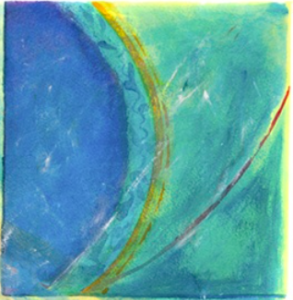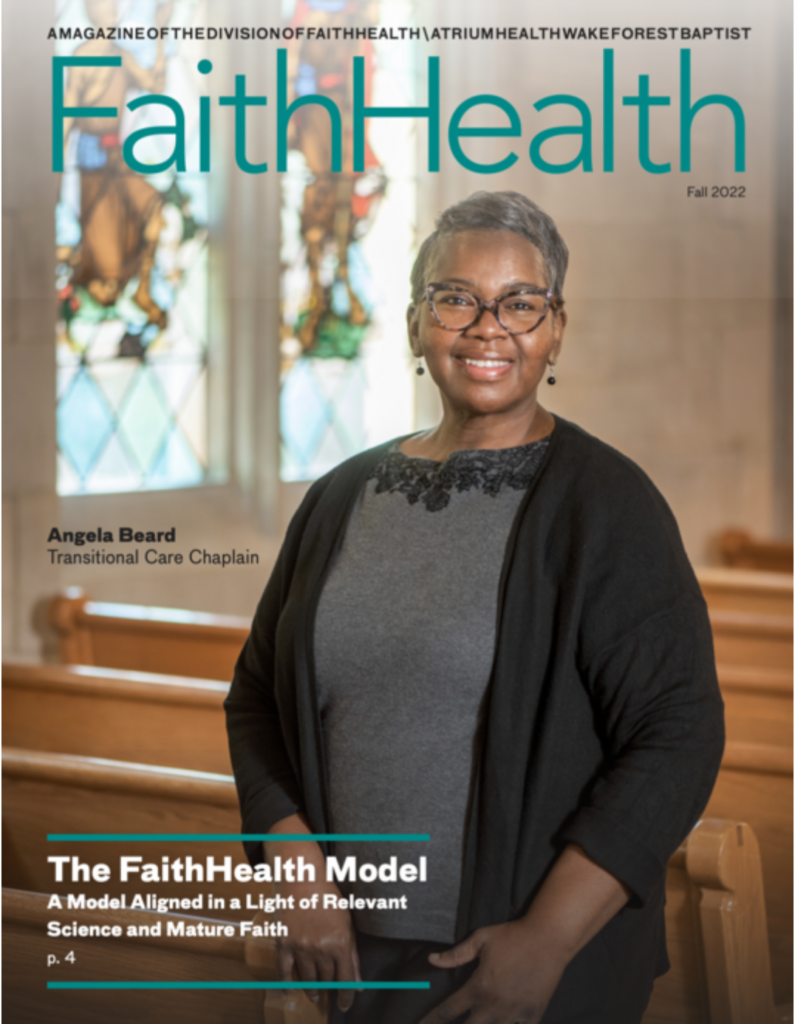Interview with Gary Gunderson
Gary Gunderson is Vice President of the FaithHealth division at Wake Forest Baptist Medical Center and co-leader of the Stakeholder Health Secretariat. He was interviewed by Tom Peterson.
Why would you like to see a broader understanding of what we include when we think about health?
I was recently in a patient case conference where we discuss individuals in the hospital who have unusual lengths of stay. Many cases are treated as a purely biological problem. And then someone says, “Oh yea, there’s a family dynamic that complicates this.” So now there are social factors. Or the person is really depressed. The psychological facet comes into play.
But rarely does someone say, “There’s some spiritual distress here.” Or this person is actually a member of a faith community that could come alongside her. Or this person’s pastor has been visiting and has been a huge help in helping him understand his own transition. Yet the practical nature of these faith assets is profound.
Every time we say health we should mean biological, psychological, social and spiritual. They’re all integrated. But this is not what traditional medicine usually thinks. Spirit is too often seen as irrelevant or as a component of the psychological dimensions of health. Many in public health think of spirit as one type of community organization that should be engaged. But they don’t understand that spirit in itself is a fourth facet of health. I like the word facet because they are more than a list of separate parts.
Those of us in healthcare should see a more vital role for spirit, spirituality, faith and religion as integral to the life journey of every patient.
What would that look like?
 One of our hospital social workers recently had a case of a person who had to be admitted for a little while but had great stress because all of her belongings were in a van in a distant county. Seeing her anxiety, the social worker found some people from a church connected to FaithHealth willing to break into the van. When asked, the patient said, “Well if they’re church folks, I’ll let them break into the van and get my belongings so I won’t worry about it.” So people in our network are able to pop a lock! Of course, we got legal sign-off documentation. It speaks to the flexibility and relevance of social networks.
One of our hospital social workers recently had a case of a person who had to be admitted for a little while but had great stress because all of her belongings were in a van in a distant county. Seeing her anxiety, the social worker found some people from a church connected to FaithHealth willing to break into the van. When asked, the patient said, “Well if they’re church folks, I’ll let them break into the van and get my belongings so I won’t worry about it.” So people in our network are able to pop a lock! Of course, we got legal sign-off documentation. It speaks to the flexibility and relevance of social networks.
Faith isn’t just ideas in our head about God, it’s this almost magical energy that creates the possibility of new relationship at a critical time in someone else’s journey. That’s when these religious networks are most relevant.
You’ve used several words such as religion, faith, spiritual. Are these interchangeable?
I find four words that describe the phenomenon using different lenses. First, religion is useful. Each religious tradition has distinct literature, practices, language, ways of worship and congregational structures. Each has different patterns of behaviors and norms and understanding of ultimate matters. Religion helps us understand the lives of patients and communities.
 Second, faith tends to be foggier. But it’s packed and powerful. Faith speaks to one’s sense of meaning. At points in our complicated life journeys we think profoundly about the meaning of it all. That “who I am in the world” context of ultimate things deeply informs our choices about how we relate to family and community and how we invest our money, imagination and life.
Second, faith tends to be foggier. But it’s packed and powerful. Faith speaks to one’s sense of meaning. At points in our complicated life journeys we think profoundly about the meaning of it all. That “who I am in the world” context of ultimate things deeply informs our choices about how we relate to family and community and how we invest our money, imagination and life.
For many it’s also moral. Almost every social service organization was started by some small group of people moved by their values and faith to do something new in the world. The American religious experience has always included an eclectic, complicated, diversity of traditions—many of which were made here. I see today a new period of great flowering social entrepreneurial activity, re-creating the social infrastructure to do good.
In recent decades many people use the third word spirituality to mean every good thing about faith. And religion is seen as every bad thing about faith, tying us to the past and tangled up in the eccentricities of a particular creedal tradition. But it’s hard to know what spirituality actually means in public discourse. I’m not clear what it positively means. But these people still want to talk about the light inside them that’s still capable of awe and a sense of worship.
 For me, the fourth word, spirit, goes more to the heart of what others mean by spirituality. A group of us was asked by the South African government’s Medical Research Council to look at one of its hardest challenges: the extremely high levels of interpersonal violence, especially younger male violence. They asked whether religion, faith, spirituality could be relevant as a positive asset and change the likelihood that a young man in a tough neighborhood would become active in violence. I was a minor advisor to that program. We felt that we needed better language. We came up with spirit. As in the United States, young men in their twenties in South Africa are the least likely to be a member of a faith tradition or active in a congregation. So we used the word spirit in our work.
For me, the fourth word, spirit, goes more to the heart of what others mean by spirituality. A group of us was asked by the South African government’s Medical Research Council to look at one of its hardest challenges: the extremely high levels of interpersonal violence, especially younger male violence. They asked whether religion, faith, spirituality could be relevant as a positive asset and change the likelihood that a young man in a tough neighborhood would become active in violence. I was a minor advisor to that program. We felt that we needed better language. We came up with spirit. As in the United States, young men in their twenties in South Africa are the least likely to be a member of a faith tradition or active in a congregation. So we used the word spirit in our work.
Spirit speaks to the African understanding that everyone has a powerful energy within that’s distinctive to his or her humanity. It’s the raw energy that makes us alive and capable of moving, changing and being. It’s creates in us the questions that ask deep meanings and helps us understand who we are in the world. Spirit speaks to energy, while spirituality speaks about experiences and ideas.
Dr. Jim Cochrane and Dr. Doug McGaughey did some basic intellectual clarifying on this that’s helped me. This notion links to Immanuel Kant’s understanding that one fundamental human distinctive is our capacity for creative freedom. We can imagine something that’s never happened, such as social relationships or institutions like hospitals. Spirit creatively frees us to then go ahead and do them.
That also makes us moral creatures and makes our institutions morally accountable. I work in a large complex institution with 14,000 individuals. We are all creatively free to find ways to do things have never been done before. We’re not trapped in the past or by this or that regulation or in someone else’s business model. We can use our energy to create a community that is merciful and just. We can blend the extraordinary powers of twenty-first century medicine with the possibilities that come out of that creative freedom.
So what do you do with that?
 This has powerful implications for twenty-first century medicine. Let’s link this sense of creative freedom with a four-fold understating of what we mean by “health.” So it’s creating new social structures, patterns in community that work out of the expectation that every patient, neighborhood and community is a biological, psychological, social and spirit-faceted reality. This informs our hopes and understanding of the problems and what we can do. In an academic medical center this has to be real science, real logic. We have to be able to see these patterns in the data in all the ways we do research.
This has powerful implications for twenty-first century medicine. Let’s link this sense of creative freedom with a four-fold understating of what we mean by “health.” So it’s creating new social structures, patterns in community that work out of the expectation that every patient, neighborhood and community is a biological, psychological, social and spirit-faceted reality. This informs our hopes and understanding of the problems and what we can do. In an academic medical center this has to be real science, real logic. We have to be able to see these patterns in the data in all the ways we do research.
Using this four-fold lens we view data differently. For instance, when we look at the trends of charity care in the five zip codes in central Winston-Salem—marked by a long-term seemingly intractable disparities—we ask what drives the numbers, the financial data. We know that financial numbers are just one marker. So we also ask what biological phenomena of health result in that cost pattern? What psychological and social structures in the communities act as assets and snares? Finally, how is spirit part of the complexity that’s creating that financial pattern?
We look at religious structures, assets, traditions and patterns for evidence of active faith. It flowers and expresses itself in different ways. Where there’s spirit, there’s evidence of energy, creative freedom that makes something happen that’s never been before. It takes imagination to understand what might be possible.
The ideal optimal healthy community doesn’t lie in the past. It has never yet been. We’ve never had what we have today: the science, technology, information, tools and connectivity. The real function of faith is to help us look into the future with optimistic uncertainty but focused through the rigorous discipline to use all four facets of the lens to bring into focus what’s possible.

